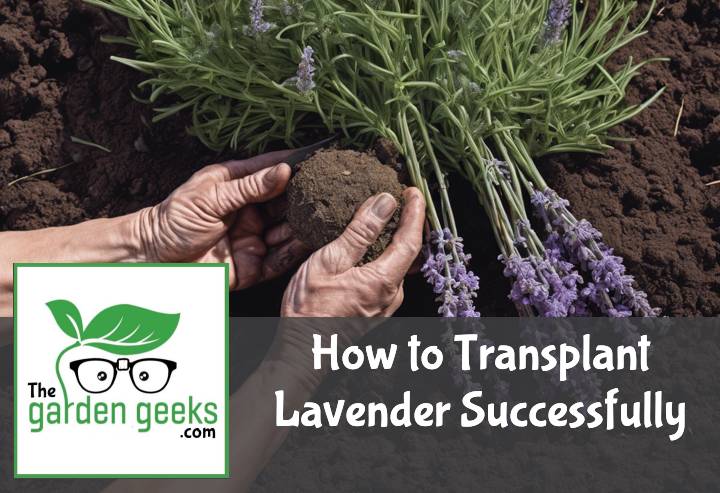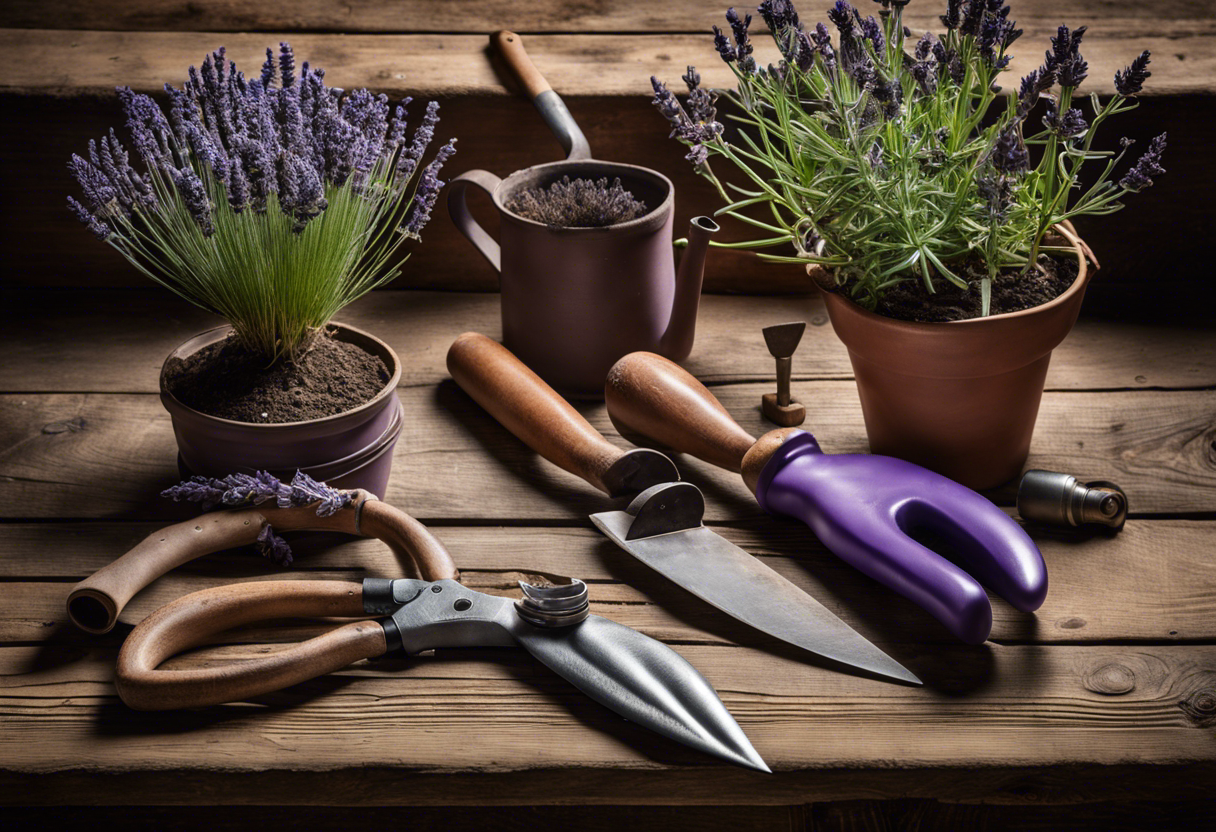Ever found yourself staring at your lavender plant, wondering How to Transplant Lavender Successfully without sending it into a death spiral of transplant shock? Trust me, you’re not alone. I’ve been there too, pot in hand, brows furrowed in worry.
But fear not! In this post, we’ll navigate the tricky waters of lavender transplantation together. So buckle up and get ready for a fun-filled journey into the world of lavender care. Keep reading about ‘How to Transplant Lavender Successfully (Avoid Transplant Shock)’.
Key Takeaways
- Choose the right time to transplant lavender, ideally in early spring or fall.
- Prepare the new location with well-draining soil and full sun exposure.
- Dig up the lavender plant carefully, preserving as much root system as possible.
- Replant immediately, placing it at the same depth it was previously growing.
- Water thoroughly after transplanting to avoid shock.
- Monitor the plant closely for signs of stress and adjust care accordingly.
Understanding Lavender and Its Transplanting Needs
When it comes to how to transplant lavender successfully, it’s crucial to understand the unique characteristics of this plant. Lavender has specific needs that, when met, can help prevent transplant shock and ensure a thriving growth.
The Ideal Environment for Lavender
Lavender plants are pretty picky about their living conditions. They prefer well-drained soil, ideally sandy or gravelly types. This is because lavenders hate having ‘wet feet’ – too much water around their roots can lead to root rot.
Sunlight is another important factor for these sun-loving plants. They need at least 6 hours of direct sunlight per day. So make sure you’re planting them in a spot where they can soak up plenty of rays.
As for climate, lavenders thrive best in Mediterranean climates – think warm, dry summers and mild winters. But don’t worry if you don’t live in such an area; with the right care, you can still have a flourishing lavender plant.
When to Transplant Lavender
Timing is everything when it comes to transplanting lavender. The best time is usually early spring or fall when the plant isn’t actively blooming.
Transplanting during these seasons gives your lavender enough time to establish its roots before the stress of blooming or harsh winter weather kicks in. It’s all about giving your lavender the best start possible!
Why Transplant Shock Occurs in Lavender
Transplant shock happens when lavenders experience sudden changes in their environment – like being moved from a pot into the ground or vice versa.
This change can cause stress leading to wilting leaves, stunted growth, or even death if not handled properly. But don’t panic! With proper lavender transplanting tips and care, you can minimize this risk.
To prevent transplant shock, try keeping changes as minimal as possible during transplantation and ensure your lavender is well-watered before and after the move. Remember, understanding lavender growth and its needs is key to a successful transplant!
Preparing for the Transplant
When it comes to how to transplant lavender successfully, preparation is key. It’s like packing for a vacation – you wouldn’t just throw things into a suitcase, would you?
Selecting a Suitable New Location for Lavender
Choosing an ideal location for your lavender is like finding the perfect sunbathing spot. Lavenders love sunlight, so pick a place that gets plenty of it. But remember, they’re not fans of soggy feet, so well-drained soil is a must.
The best soil type for lavender is sandy or gravelly. So if your garden has clay-like soil, you might want to consider adding some grit or sand before planting. This will ensure that your lavender doesn’t end up with waterlogged roots.
Preparing the Soil for Transplantation
Now let’s talk about getting that soil ready for your lavender’s big move. You’ve got to make sure it feels right at home in its new spot! Start by loosening the soil with a garden fork or tiller.
Next, mix in some compost or organic matter. This will improve the soil structure and provide nutrients for your plant. Remember, ensuring successful lavender transplant involves giving it everything it needs to thrive!
Watering Considerations Before Transplantation
Finally, let’s chat about watering before transplantation. You don’t want to drown your lavender before moving day! Instead, aim to keep the soil moist but not waterlogged.
Proper watering techniques can help avoid transplant shock in lavenders. Think of it as hydrating before a workout – it helps prepare your plant for the big move and reduces stress on its system.
So there you have it folks! The basics of lavender transplant preparation are all about location, soil prep and watering considerations. Now go forth and transplant with confidence!
The Process of Transplanting Lavender
Transplanting lavender is a delicate dance between uprooting and replanting. It’s all about the careful extraction of the plant from its current home and the gentle introduction to its new one. Each step in this lavender transplant process is crucial for successful lavender transplantation.
How to Uproot the Lavender Safely
When it comes to safely uprooting lavender, it’s not just about yanking it out of the ground. Nope, you need to be as gentle as a summer breeze. Start by loosening the soil around the plant with a garden fork. This helps minimize plant stress and prevents damage during uprooting.
Now, here’s where your green thumb comes in handy. You’ve got to carefully lift the lavender from beneath, supporting those precious roots. Remember, these roots are like the heart of your plant – they need some serious TLC! So apply those techniques for uprooting lavender and show that lavender root care some love!
Planting the Uprooted Lavender in the New Location
Once you’ve successfully uprooted your lavender, it’s time for phase two: replantation. But hold on there, green thumb! Before you go sticking that lavender into any old dirt pile, let’s talk soil preparation for lavender.
Firstly, ensure that your new location has well-draining soil – lavenders hate wet feet! Add some compost or organic matter if needed; this will provide nutrients and improve drainage.
Next step: planting techniques for transplanted lavenders. Make a hole deep enough to accommodate those beautiful roots without bending them. Then gently place your lavender in and cover with soil.
Finally, don’t forget about care after replantation! Water it lightly (remember what we said about wet feet!) and keep an eye on it over the next few weeks. With these steps, you’ll know how to transplant lavender successfully!
Post-Transplant Care for Lavender
After you’ve mastered how to transplant lavender successfully, it’s time to focus on the aftercare. This includes watering, feeding, and monitoring your lavender’s health and growth.
Watering and Feeding After Transplantation
Watering is crucial in lavender care after transplant. But remember, lavenders are like those friends who prefer a good chat over a cup of tea rather than a pool party. So, don’t drown them! Instead, provide enough water to keep the soil slightly moist.
Feeding your newly transplanted lavender is also important. A slow-release fertilizer can be your best bet here. It’ll feed your plant gradually without overwhelming it.
Monitoring Growth and Health Post-Transplant
Now comes the fun part – watching your lavender grow! Keep an eye on its growth post-transplant. If you see new shoots popping up like eager kids in a candy store, you’re on the right track.
But what about assessing health of transplanted lavender? Well, if your lavender looks happy with bright green leaves and starts to bloom, give yourself a pat on the back! You’ve done well in maintaining lavender health post-transplant.
Troubleshooting Common Issues After Transplantation
After mastering how to transplant lavender successfully, it’s crucial to stay vigilant for any signs of distress. Lavenders, like other plants, can experience a range of issues post-transplant, including the dreaded transplant shock.
Identifying Signs of Transplant Shock in Lavenders
So, how do you know if your lavender is suffering from transplant shock? Well, there are a few telltale signs to look out for. Your plant might start wilting or dropping leaves. You may also notice a slowdown in growth or even some browning on the edges of the leaves.
These are all classic signs of transplant shock and clear indicators that your lavender is under stress. It’s essential to diagnose this early so you can take steps to help your plant recover.
How to Help a Shocked Plant Recover
If you find your lavender showing these symptoms, don’t panic! There are several ways you can help it bounce back. First off, ensure it’s getting plenty of water – but not too much! Overwatering can cause root rot which will only add to its problems.
Next up, consider adding some organic matter like compost or well-rotted manure to the soil around your plant. This will provide essential nutrients and promote healing in your shocked plant.
Remember, patience is key when managing stressed plants. With proper care and attention, your lavender should be back on track in no time!
To Wrap Up
In the garden of life, transplanting lavender is like teaching an old dog new tricks. It’s tricky but not impossible. Remember, lavender plants are just like us—they need a bit of TLC to settle into their new homes.
So, don’t be a stranger! Visit our guide on How to Transplant Lavender Successfully whenever you need. And remember: green thumbs aren’t born, they’re made!





